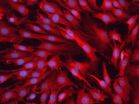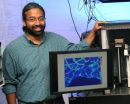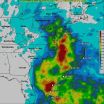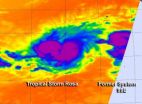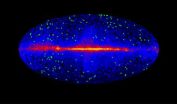(Press-News.org) Adding an angiogenesis inhibitor to treatment with a HER2-inhibiting drug could improve outcomes for patients with HER2-positive breast cancer who develop brain metastases. In their report published online in PNAS Plus, Massachusetts General Hospital (MGH) investigators report the first preclinical study combining antiangiogenic and anti-HER2 drugs in an animal model of brain metastatic breast cancer.
"We have shown dramatic improvement in survival by slowing the growth of brain metastatic, HER2-amplified breast cancer," says Rakesh Jain, PhD, director of the Steele Laboratory for Tumor Biology at MGH, Cook Professor of Radiation Oncology (Tumor Biology) at Harvard Medical School and senior author of the study. "This is particularly important because patients with this type of breast cancer have an increased risk of brain metastases, which have not responded to current therapies."
A quarter of breast cancers are driven by overexpression of the growth factor HER2, making them particularly aggressive. Treatment with drugs that block the pathway controlled by HER2 – trastuzumab (Herceptin) and lapatinib (Tykerb) – suppresses the growth of these tumors and extends patient survival. But these patients are at increased risk of developing brain metastases, which have resisted anti-HER2 treatment. Angiogenesis is also known to have an important role in breast cancer, and although previous studies combining chemotherapy with the antiangiogenesis drug bevacizumab (Avastin) delayed disease progression, they have not extended overall survival.
In addition to directly blocking the HER2-controlled growth pathway, anti-HER2 drugs also contribute to suppression of tumor-associated blood vessels. Previous studies in Jain's lab suggested that the proangiogenic factor VEGF may overcome the antiangiogenic effects of anti-HER2 drugs. This observation led the researchers to investigate whether blocking the VEGF pathway would improve the results of anti-HER2 treatment. Their study used a new mouse model in which the proliferation of HER2-amplified breast cancer cells implanted into brain tissue could be monitored over time. The researchers first confirmed that, as in human patients, treatment with a single anti-HER2 drug suppressed tumor growth in breast tissue but not within the brain.
While treatment with DC101, an antibody that blocks the VEGF pathway in mice, improved survival compared with either anti-HER2 drug, combining DC101 with one anti-HER2 drugs produced even greater survival improvement, including the death of tumor cells through significant reduction in tumor-associated angiogenesis. A triple combination of DC101 with both anti-HER2 drugs had the most dramatic effects. Animals receiving a single anti-HER2 drug along with DC101 lived more than three times as long as control animals, while those receiving all three drugs lived five times as long.
Jeffrey Engelman, MD, PhD, of the MGH Cancer Center, co-corresponding author of the PNAS Plus report, notes that a clinical trial now underway combining chemotherapy with bevacizumab in breast cancer addsanti-HER2 treatment for those participants whose tumors are HER2-amplified. The results of the current MGH study suggest that investigating a triple combination may be particularly beneficial. "With targeted therapies like anti-HER2 drugs suppressing the growth of tumors outside the central nervous system, brain metastasis is becoming a more common cause of treatment failure."
Co-corresponding author Dai Fukumura, MD, PhD, of the Steele Lab adds, "A clinical trial of this sort of triple combination will be an important next step. And in the meantime, we will continue to investigate the mechanisms of resistance to the effects of both double and triple combinations." Fukumura is an associate professor of Radiation Oncology and Engelman an associate professor of Medicine at Harvard Medical School.
INFORMATION:
Co-lead authors of the PNAS Plus article are David Kodack, PhD, Euiheon Chung and Hiroshi Yamashita of the Steele Lab. Additional co-author are Joao Incio, MD, Annique Duyverman, Yuhui Huang, PhD, Eleanor Ager, PhD, Walid Kamoun, Shom Goel, MBBS, Matija Snuderl, MD, Alisha Lussiez, Lotte Hiddingh and Sidra Mahmood, Steele Lab; Youngchul Song and April Eichler, MD, MGH Cancer Center; Christian Farrar, PhD, MGH Martinos Center for Biomedical Imaging, and Bakhos Tannous, PhD, MGH Neurology. Support for the study includes grants from the National Cancer Institute and a Breast Cancer Research Innovator Award from the Department of Defense
Massachusetts General Hospital, founded in 1811, is the original and largest teaching hospital of Harvard Medical School. The MGH conducts the largest hospital-based research program in the United States, with an annual research budget of more than $750 million and major research centers in AIDS, cardiovascular research, cancer, computational and integrative biology, cutaneous biology, human genetics, medical imaging, neurodegenerative disorders, regenerative medicine, reproductive biology, systems biology, transplantation biology and photomedicine. In July 2012, MGH moved into the number one spot on the 2012-13 U.S. News & World Report list of "America's Best Hospitals."
END
PHILADELPHIA - Arterial stiffening has long been considered a major risk factor for cardiovascular disease. Keeping arteries soft and supple might reduce disease risk, but the mechanisms of how arteries stave off hardening has remained elusive.
Researchers from the Perelman School of Medicine, University of Pennsylvania, Wistar Institute, and The Children's Hospital of Philadelphia have discovered that the protein apolipoprotein E (apoE) plays a major role in maintaining arterial softness by suppressing production of the extracellular matrix, a network of connective ...
AMES, Iowa – The human body has more than a trillion cells, most of them connected, cell to neighboring cells.
How, exactly, do those bonds work? What happens when a pulling force is applied to those bonds? How long before they break? Does a better understanding of all those bonds and their responses to force have implications for fighting disease?
Sanjeevi Sivasankar, an Iowa State assistant professor of physics and astronomy and an associate of the U.S. Department of Energy's Ames Laboratory, is leading a research team that's answering those questions as it studies ...
NASA's Tropical Rainfall Measuring Mission, or TRMM, satellite acts as a rain gauge in space as it orbits the Earth's tropics. As TRMM flew over Hurricane Sandy since its birth on Oct. 21 it was gathering data that has now been mapped to show how much rain the storm dropped along the U.S. eastern seaboard.
Much of the recent deadly flooding along the northeastern United States coastlines was caused by super storm Sandy's storm swell. Strong winds from Sandy persistently pushed Atlantic Ocean waters toward the coast. High tides that occurred at the same time also magnified ...
Wind shear is pushing the bulk of Tropical Storm Rosa southeast of the storm's center, and that's evident on infrared imagery from NASA's Aqua satellite. Meanwhile System 99E, that was trailing behind Rosa on Oct. 31, has now "given up the ghost" as a result of that same wind shear.
When NASA's Aqua satellite flew over Tropical Storm Rosa at 5:41 a.m. EDT (0951 UTC) on Nov. 1, 2012 the Atmospheric Infrared Sounder (AIRS) instrument took an infrared picture of Tropical Storm Rosa and remnants of System 99E. The AIRS data showed the strongest convection (rising air that ...
Parents with social anxiety disorder are more likely than parents with other forms of anxiety to engage in behaviors that put their children at high risk for developing angst of their own, according to a small study of parent-child pairs conducted at Johns Hopkins Children's Center.
Authors of the federally funded study say past research has linked parental anxiety to anxiety in children, but it remained unclear whether people with certain anxiety disorders engaged more often in anxiety-provoking behaviors. Based on the new study findings, they do. A report on the team's ...
After Tropical Cyclone Nilam made landfall in southeastern India NASA's Terra satellite passed overhead and saw the storm's clouds blanket the entire southern portion of the country from Chennai southward.
On Nov. 1 at 05:50 UTC (1:50 a.m. EDT), the Moderate Resolution Imaging Spectroradiometer (MODIS) instrument that flies aboard NASA's Terra satellite captured a visible image of Tropical Depression Nilam.
The MODIS image showed that Nilam's clouds stretched as far north as Andra Pradesh, a state in east central India. It covered the states of Goa and Karnataka in ...
For many American teens, the road to college goes through the chapel.
Sociologists from Brigham Young University and Rice University found religiously-affiliated youth are 40 percent more likely to graduate high school than their unaffiliated peers and 70 percent more likely to enroll in college.
The researchers note that teens' fellow church-goers are an important factor, serving as mentors who help teens set their sights high.
"Youth have a unique chance to form relationships with peers and mentors outside of their classroom at school or their neighborhood at home," ...
The Suomi National Polar-orbiting Partnership (NPP) satellitecaptured a night-time view of New York City, New Jersey and eastern Pennsylvania that revealed the extent of the power outages caused from Hurricane Sandy's landfall on October 29. Suomi NPP is a partnership between NASA, the National Oceanic and Atmospheric Administration (NOAA), and the U.S. Department of Defense.
The Visible Infrared Imaging Radiometer Suite (VIIRS) on Suomi NPP captured a night-time view of the Mid-Atlantic on the morning of Nov. 1, 2012,revealing areas where power has not been currently ...
VIDEO:
This animation tracks several gamma rays through space and time, from their emission in the jet of a distant blazar to their arrival in Fermi's Large Area Telescope (LAT). During...
Click here for more information.
Astronomers using data from NASA's Fermi Gamma-ray Space Telescope have made the most accurate measurement of starlight in the universe and used it to establish the total amount of light from all of the stars that have ever shone, accomplishing a primary ...
Solar systems with life-bearing planets may be rare if they are dependent on the presence of asteroid belts of just the right mass, according to a study by Rebecca Martin, a NASA Sagan Fellow from the University of Colorado in Boulder, and astronomer Mario Livio of the Space Telescope Science Institute in Baltimore, Md.
They suggest that the size and location of an asteroid belt, shaped by the evolution of the sun's protoplanetary disk and by the gravitational influence of a nearby giant Jupiter-like planet, may determine whether complex life will evolve on an Earth-like ...
